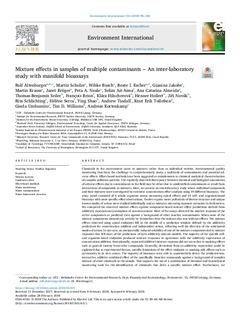| dc.contributor.author | Altenburger, Rolf | |
| dc.contributor.author | Scholze, Martin | |
| dc.contributor.author | Busch, Wibke | |
| dc.contributor.author | Escher, Beate | |
| dc.contributor.author | Jakobs, Gianina | |
| dc.contributor.author | Krauss, Martin | |
| dc.contributor.author | Krüger, Janet | |
| dc.contributor.author | Neale, Peta A. | |
| dc.contributor.author | Aït-Aïssa, Selim | |
| dc.contributor.author | Almeida, Ana Catarina | |
| dc.contributor.author | Seiler, Thomas-Benjamin | |
| dc.contributor.author | Brion, François | |
| dc.contributor.author | Hilscherová, Klára | |
| dc.contributor.author | Hollert, Henner | |
| dc.contributor.author | Novak, Jiri | |
| dc.contributor.author | Schlichting, Rita | |
| dc.contributor.author | Serra, Helene | |
| dc.contributor.author | Shao, Ying | |
| dc.contributor.author | Tindall, Andrew | |
| dc.contributor.author | Tollefsen, Knut-Erik | |
| dc.contributor.author | Umbuzeiro, Gisela de Aragão | |
| dc.contributor.author | Williams, Timothy D. | |
| dc.contributor.author | Kortenkamp, Andreas | |
| dc.date.accessioned | 2019-05-10T07:58:35Z | |
| dc.date.available | 2019-05-10T07:58:35Z | |
| dc.date.created | 2019-01-04T09:41:20Z | |
| dc.date.issued | 2018 | |
| dc.identifier.citation | Environment International. 2018, 114, 95-106. | nb_NO |
| dc.identifier.issn | 0160-4120 | |
| dc.identifier.uri | http://hdl.handle.net/11250/2597183 | |
| dc.description.abstract | Chemicals in the environment occur in mixtures rather than as individual entities. Environmental quality monitoring thus faces the challenge to comprehensively assess a multitude of contaminants and potential adverse effects. Effect-based methods have been suggested as complements to chemical analytical characterisation of complex pollution patterns. The regularly observed discrepancy between chemical and biological assessments of adverse effects due to contaminants in the field may be either due to unidentified contaminants or result from interactions of compounds in mixtures. Here, we present an interlaboratory study where individual compounds and their mixtures were investigated by extensive concentration-effect analysis using 19 different bioassays. The assay panel consisted of 5 whole organism assays measuring apical effects and 14 cell- and organism-based bioassays with more specific effect observations. Twelve organic water pollutants of diverse structure and unique known modes of action were studied individually and as mixtures mirroring exposure scenarios in freshwaters. We compared the observed mixture effects against component-based mixture effect predictions derived from additivity expectations (assumption of non-interaction). Most of the assays detected the mixture response of the active components as predicted even against a background of other inactive contaminants. When none of the mixture components showed any activity by themselves then the mixture also was without effects. The mixture effects observed using apical endpoints fell in the middle of a prediction window defined by the additivity predictions for concentration addition and independent action, reflecting well the diversity of the anticipated modes of action. In one case, an unexpectedly reduced solubility of one of the mixture components led to mixture responses that fell short of the predictions of both additivity mixture models. The majority of the specific cell- and organism-based endpoints produced mixture responses in agreement with the additivity expectation of concentration addition. Exceptionally, expected (additive) mixture response did not occur due to masking effects such as general toxicity from other compounds. Generally, deviations from an additivity expectation could be explained due to experimental factors, specific limitations of the effect endpoint or masking side effects such as cytotoxicity in in vitro assays. The majority of bioassays were able to quantitatively detect the predicted non-interactive, additive combined effect of the specifically bioactive compounds against a background of complex mixture of other chemicals in the sample. This supports the use of a combination of chemical and bioanalytical monitoring tools for the identification of chemicals that drive a specific mixture effect. Furthermore, we demonstrated that a panel of bioassays can provide a diverse profile of effect responses to a complex contaminated sample. This could be extended towards representing mixture adverse outcome pathways. Our findings support the ongoing development of bioanalytical tools for (i) compiling comprehensive effect-based batteries for water quality assessment, (ii) designing tailored surveillance methods to safeguard specific water uses, and (iii) devising strategies for effect-based diagnosis of complex contamination. | nb_NO |
| dc.language.iso | eng | nb_NO |
| dc.rights | Attribution-NonCommercial-NoDerivatives 4.0 Internasjonal | * |
| dc.rights.uri | http://creativecommons.org/licenses/by-nc-nd/4.0/deed.no | * |
| dc.title | Mixture effects in samples of multiple contaminants – An inter-laboratory study with manifold bioassays | nb_NO |
| dc.type | Journal article | nb_NO |
| dc.type | Peer reviewed | nb_NO |
| dc.description.version | publishedVersion | nb_NO |
| dc.rights.holder | © 2018 The Authors | nb_NO |
| dc.source.pagenumber | 95-106 | nb_NO |
| dc.source.volume | 114 | nb_NO |
| dc.source.journal | Environment International | nb_NO |
| dc.identifier.doi | 10.1016/j.envint.2018.02.013 | |
| dc.identifier.cristin | 1650124 | |
| dc.relation.project | EC/FP7/SOLUTIONS | nb_NO |
| cristin.unitcode | 7464,0,0,0 | |
| cristin.unitname | Norsk institutt for vannforskning | |
| cristin.ispublished | true | |
| cristin.fulltext | original | |
| cristin.qualitycode | 1 | |

